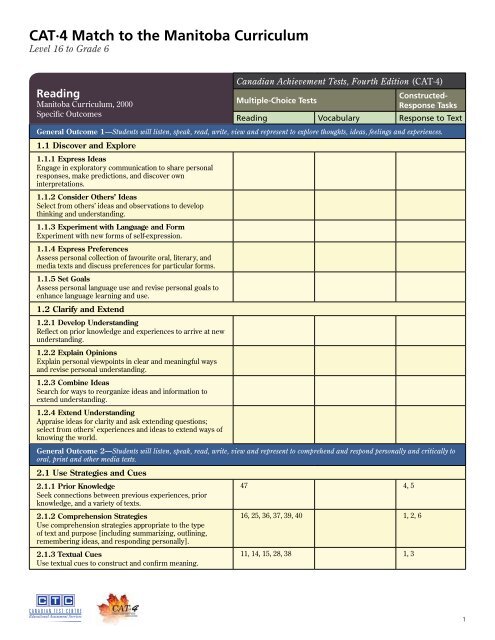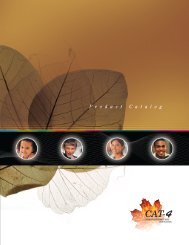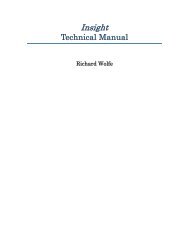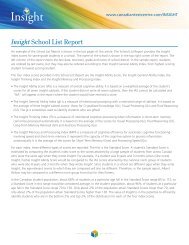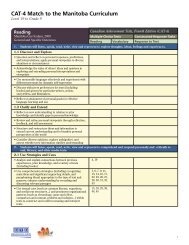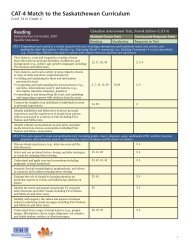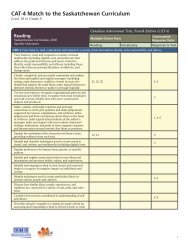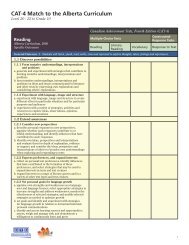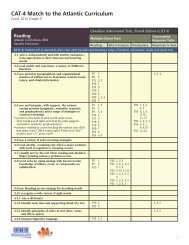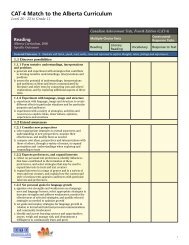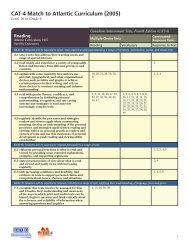Grade 6 - Canadian Test Centre
Grade 6 - Canadian Test Centre
Grade 6 - Canadian Test Centre
You also want an ePaper? Increase the reach of your titles
YUMPU automatically turns print PDFs into web optimized ePapers that Google loves.
CAT∙4 Match to the Manitoba Curriculum<br />
Level 16 to <strong>Grade</strong> 6<br />
Reading<br />
Manitoba Curriculum, 2000<br />
Specific Outcomes<br />
<strong>Canadian</strong> Achievement <strong>Test</strong>s, Fourth Edition (CAT·4)<br />
Multiple-Choice <strong>Test</strong>s<br />
Constructed-<br />
Response Tasks<br />
Reading Vocabulary Response to Text<br />
General Outcome 1—Students will listen, speak, read, write, view and represent to explore thoughts, ideas, feelings and experiences.<br />
1.1 Discover and Explore<br />
1.1.1 Express Ideas<br />
Engage in exploratory communication to share personal<br />
responses, make predictions, and discover own<br />
interpretations.<br />
1.1.2 Consider Others’ Ideas<br />
Select from others’ ideas and observations to develop<br />
thinking and understanding.<br />
1.1.3 Experiment with Language and Form<br />
Experiment with new forms of self-expression.<br />
1.1.4 Express Preferences<br />
Assess personal collection of favourite oral, literary, and<br />
media texts and discuss preferences for particular forms.<br />
1.1.5 Set Goals<br />
Assess personal language use and revise personal goals to<br />
enhance language learning and use.<br />
1.2 Clarify and Extend<br />
1.2.1 Develop Understanding<br />
Reflect on prior knowledge and experiences to arrive at new<br />
understanding.<br />
1.2.2 Explain Opinions<br />
Explain personal viewpoints in clear and meaningful ways<br />
and revise personal understanding.<br />
1.2.3 Combine Ideas<br />
Search for ways to reorganize ideas and information to<br />
extend understanding.<br />
1.2.4 Extend Understanding<br />
Appraise ideas for clarity and ask extending questions;<br />
select from others’ experiences and ideas to extend ways of<br />
knowing the world.<br />
General Outcome 2—Students will listen, speak, read, write, view and represent to comprehend and respond personally and critically to<br />
oral, print and other media texts.<br />
2.1 Use Strategies and Cues<br />
2.1.1 Prior Knowledge<br />
Seek connections between previous experiences, prior<br />
knowledge, and a variety of texts.<br />
2.1.2 Comprehension Strategies<br />
Use comprehension strategies appropriate to the type<br />
of text and purpose [including summarizing, outlining,<br />
remembering ideas, and responding personally].<br />
2.1.3 Textual Cues<br />
Use textual cues to construct and confirm meaning.<br />
47 4, 5<br />
16, 25, 36, 37, 39, 40 1, 2, 6<br />
11, 14, 15, 28, 38 1, 3<br />
1
CAT∙4 Match to the Manitoba Curriculum<br />
Level 16 to <strong>Grade</strong> 6<br />
Reading<br />
Manitoba Curriculum, 2000<br />
Specific Outcomes<br />
2.1.4 Cueing Systems<br />
Use syntactic, semantic, and graphophonic cueing systems<br />
[including word order, context clues; and multiple meanings<br />
of words, structural analysis to identify roots, prefixes, and<br />
suffixes] to construct and confirm meaning; use a dictionary<br />
to determine word meaning in context.<br />
2.2 Respond to Texts<br />
2.2.1 Experience Various Texts<br />
Seek opportunities to experience texts from a variety of<br />
forms and genres and cultural traditions; share responses<br />
2.2.2 Connect Self, Texts, and Culture<br />
Discuss own and others’ understanding of various<br />
community and cultural traditions in various places<br />
and times as portrayed in oral, literary, and media texts<br />
[including texts about Canada or by <strong>Canadian</strong> writers].<br />
2.2.3 Appreciate the Artistry of Texts<br />
Identify descriptive and figurative language in oral, literary,<br />
and media texts and discuss how it enhances understanding<br />
of people, places, and action.<br />
2.3 Understand Forms and Techniques<br />
2.3.1 Forms and Genre<br />
Recognize key characteristics of various forms and genres<br />
of oral, literary, and media texts.<br />
2.3.2 Techniques and Elements<br />
Identify significant elements and techniques in oral, literary,<br />
and media texts, and examine how they interact to create<br />
effects.<br />
2.3.3 Vocabulary<br />
Experiment with ambiguity in language in a variety of<br />
contexts.<br />
2.3.4 Experiment with Language<br />
Alter words, forms, and sentence patterns to create new<br />
versions of texts for a variety of purposes; explain ways in<br />
which figures of speech clarify and enhance meaning.<br />
2.3.5 Create Original Texts<br />
Create original texts to communicate and demonstrate<br />
understanding of forms and techniques.<br />
<strong>Canadian</strong> Achievement <strong>Test</strong>s, Fourth Edition (CAT·4)<br />
Multiple-Choice <strong>Test</strong>s<br />
Constructed-<br />
Response Tasks<br />
Reading Vocabulary Response to Text<br />
1, 24, 33, 35, 44, 45 1, 2, 3, 4, 5, 6, 7, 8, 9, 5<br />
10, 11, 12, 13, 14, 15,<br />
16, 17, 18, 19, 20, 21,<br />
22, 23, 24, 25, 26, 27,<br />
28, 29, 30, 31, 32, 33,<br />
34, 35, 36, 37, 38, 39,<br />
40<br />
19, 27, 43<br />
13, 23<br />
46, 48 3<br />
General Outcome 3—Students will listen, speak, read, write, view and represent to manage ideas and information.<br />
3.1 Plan and Focus<br />
3.1.1 Use Personal Knowledge<br />
Summarize and focus personal knowledge of a topic to<br />
determine information needs.<br />
2<br />
3<br />
2
CAT∙4 Match to the Manitoba Curriculum<br />
Level 16 to <strong>Grade</strong> 6<br />
Reading<br />
Manitoba Curriculum, 2000<br />
Specific Outcomes<br />
3.1.2 Ask Questions<br />
Formulate relevant questions to focus information needs for<br />
an inquiry.<br />
3.1.3 Contribute to Group Inquiry<br />
Contribute to group knowledge of topics to help identify and<br />
focus information needs, sources, and purposes for group<br />
inquiry or research.<br />
3.1.4 Create and Follow a Plan<br />
Create and follow a plan to collect and record information<br />
within a pre-established time frame.<br />
3.2 Select and Process<br />
3.2.1 Identify Personal and Peer Knowledge<br />
Recall, record and organize personal and peer knowledge of<br />
a topic for inquiry or research.<br />
3.2.2 Identify Sources<br />
Answer inquiry and research questions using a variety of<br />
information sources.<br />
3.2.3 Assess Sources<br />
Recognize that information serves different purposes and<br />
determine its usefulness for inquiry or research focus using<br />
pre-established criteria.<br />
3.2.4 Access Information<br />
Use a variety of tools [including bibliographies, thesauri, and<br />
technology] to access information and ideas; use visual and<br />
auditory cues.<br />
3.2.5 Make Sense of Information<br />
Use organizational patterns of oral, visual, and written texts<br />
[including main ideas and supporting details, explanation,<br />
comparison and contrast, cause and effect, and sequence]<br />
to construct meaning; skim, scan and read closely to gather<br />
information.<br />
3.3 Organize, Record, and Assess<br />
3.3.1 Organize Information<br />
Organize information and ideas using a variety of strategies<br />
and techniques.<br />
3.3.2 Record Information<br />
Make notes on a topic, combining information from more<br />
than one source; reference sources appropriately.<br />
3.3.3 Evaluate Information<br />
Evaluate the appropriateness of information for a particular<br />
form, audience, and purpose; identify gaps in information<br />
collected and gather additional information.<br />
3.3.4 Develop New Understanding<br />
Relate gathered information to prior knowledge to reach<br />
conclusions or develop points of view; establish goals for<br />
developing further inquiry or research skills.<br />
<strong>Canadian</strong> Achievement <strong>Test</strong>s, Fourth Edition (CAT·4)<br />
Multiple-Choice <strong>Test</strong>s<br />
Constructed-<br />
Response Tasks<br />
Reading Vocabulary Response to Text<br />
12, 34, 41<br />
2, 3, 4, 5, 6, 7, 8, 9,<br />
17, 18, 20, 21, 22, 26,<br />
29, 31<br />
2, 3, 5, 6<br />
1, 4, 6<br />
10, 30, 32 1, 3, 4, 5, 6<br />
3
CAT∙4 Match to the Manitoba Curriculum<br />
Level 16 to <strong>Grade</strong> 6<br />
Writing<br />
Manitoba Curriculum, 2000<br />
Specific Outcomes<br />
<strong>Canadian</strong> Achievement <strong>Test</strong>s, Fourth Edition (CAT·4)<br />
Multiple-Choice <strong>Test</strong>s<br />
Writing<br />
Spelling<br />
Conventions<br />
Constructed-Response Tasks<br />
Writing<br />
General Outcome 2—Students will listen, speak, read, write, view and represent to comprehend and respond personally and critically to<br />
oral, print and other media texts.<br />
2.1 Use Strategies and Cues<br />
2.1.1 Prior Knowledge<br />
Seek connections between previous experiences, prior<br />
knowledge, and a variety of texts.<br />
2.1.2 Comprehension Strategies<br />
Use comprehension strategies appropriate to the type<br />
of text and purpose [including summarizing, outlining,<br />
remembering ideas, and responding personally].<br />
2.1.3 Textual Cues<br />
Use textual cues to construct and confirm meaning.<br />
2.1.4 Cueing Systems<br />
Use syntactic, semantic, and graphophonic cueing systems<br />
[including word order, context clues; and multiple meanings<br />
of words, structural analysis to identify roots, prefixes, and<br />
suffixes] to construct and confirm meaning; use a dictionary<br />
to determine word meaning in context.<br />
2.2 Respond to Texts<br />
2.2.1 Experience Various Texts<br />
Seek opportunities to experience texts from a variety of<br />
forms and genres and cultural traditions; share responses<br />
2.2.2 Connect Self, Texts, and Culture<br />
Discuss own and others’ understanding of various<br />
community and cultural traditions in various places<br />
and times as portrayed in oral, literary, and media texts<br />
[including texts about Canada or by <strong>Canadian</strong> writers].<br />
2.2.3 Appreciate the Artistry of Texts<br />
Identify descriptive and figurative language in oral, literary,<br />
and media texts and discuss how it enhances understanding<br />
of people, places, and action.<br />
2.3 Understand forms and genres<br />
2.3.1 Forms and Genre<br />
Recognize key characteristics of various forms and genres<br />
of oral, literary, and media texts.<br />
2.3.2 Techniques and Elements<br />
Identify significant elements and techniques in oral, literary,<br />
and media texts, and examine how they interact to create<br />
effects.<br />
2.3.3 Vocabulary<br />
Experiment with ambiguity in language in a variety of<br />
contexts.<br />
2.3.4 Experiment with Language<br />
Alter words, forms, and sentence patterns to create new<br />
versions of texts for a variety of purposes; explain ways in<br />
which figures of speech.<br />
27, 28, 29, 30,<br />
31, 32, 33, 34,<br />
35<br />
1, 2, 3, 4, 5<br />
1, 2, 3, 4, 5<br />
4
CAT∙4 Match to the Manitoba Curriculum<br />
Level 16 to <strong>Grade</strong> 6<br />
Writing<br />
Manitoba Curriculum, 2000<br />
Specific Outcomes<br />
2.3.5 Create Original Texts<br />
Create original texts to communicate and demonstrate<br />
understanding of forms and techniques.<br />
<strong>Canadian</strong> Achievement <strong>Test</strong>s, Fourth Edition (CAT·4)<br />
Multiple-Choice <strong>Test</strong>s<br />
Writing<br />
Spelling<br />
Conventions<br />
Constructed-Response Tasks<br />
Writing<br />
1, 2, 3, 4, 5<br />
General Outcome 3—Students will listen, speak, read, write, view and represent to manage ideas and information.<br />
3.1 Plan and Focus<br />
3.1.1 Use Personal Knowledge<br />
Summarize and focus personal knowledge of a topic to<br />
determine information needs.<br />
3.1.2 Ask Questions<br />
Formulate relevant questions to focus information needs for<br />
an inquiry.<br />
3.1.3 Contribute to Group Inquiry<br />
Contribute to group knowledge of topics to help identify and<br />
focus information needs, sources, and purposes for group<br />
inquiry or research.<br />
3.1.4 Create and Follow a Plan<br />
Create and follow a plan to collect and record information<br />
within a pre-established time frame.<br />
3.2 Select and Process<br />
3.2.1 Identify Personal and Peer Knowledge<br />
Recall, record and organize personal and peer knowledge of<br />
a topic for inquiry or research.<br />
3.2.2 Identify Sources<br />
Answer inquiry and research questions using a variety of<br />
information sources.<br />
3.2.3 Assess Sources<br />
Recognize that information serves different purposes and<br />
determine its usefulness for inquiry or research focus using<br />
pre-established criteria.<br />
3.2.4 Access Information<br />
Use a variety of tools [including bibliographies, thesauri,<br />
and technology] to access information and ideas; use visual<br />
and auditory cues to identify relevant information.<br />
3.2.5 Make Sense of Information<br />
Use organizational patterns of oral, visual, and written texts<br />
[including main ideas and supporting details, explanation,<br />
comparison and contrast, cause and effect, and sequence]<br />
to construct meaning; skim, scan and read closely to gather<br />
information.<br />
3.3 Organize, Record and Evaluate<br />
3.3.1 Organize Information<br />
Organize information and ideas using a variety of strategies<br />
and techniques.<br />
3.3.2 Record Information<br />
Make notes on a topic, combining information from more<br />
than one source; reference sources appropriately.<br />
36, 37, 38, 39,<br />
40<br />
1, 2, 5<br />
3, 4, 5<br />
5
CAT∙4 Match to the Manitoba Curriculum<br />
Level 16 to <strong>Grade</strong> 6<br />
Writing<br />
Manitoba Curriculum, 2000<br />
Specific Outcomes<br />
3.3.3 Evaluate Information<br />
Evaluate the appropriateness of information for a particular<br />
form, audience, and purpose; identify gaps in information<br />
collected and gather additional information.<br />
3.3.4 Develop New Understanding<br />
Relate gathered information to prior knowledge to reach<br />
conclusions or develop points of view; establish goals for<br />
developing further inquiry or research skills.<br />
<strong>Canadian</strong> Achievement <strong>Test</strong>s, Fourth Edition (CAT·4)<br />
Multiple-Choice <strong>Test</strong>s<br />
Writing<br />
Spelling<br />
Conventions<br />
Constructed-Response Tasks<br />
Writing<br />
General Outcome 4—Students will listen, speak, read, write, view and represent to enhance the clarity and artistry of communication.<br />
4.1 Generate and Focus<br />
4.1.1 Generate Ideas<br />
4, 5<br />
Focus a topic for oral, written, and visual texts integrating<br />
ideas from experiences and a variety of other sources.<br />
4.1.2 Choose Forms<br />
Select specific forms that serve particular audiences and<br />
purposes.<br />
4.1.3 Organize Ideas<br />
Adapt models from listening, reading, and viewing<br />
experiences to enhance own oral, written, and visual texts<br />
using organizational patterns.<br />
4.2 Enhance and Improve<br />
4.2.1 Appraise Own and Others’ Work<br />
Share own stories and creations at appropriate times during<br />
revision and use criteria to provide feedback for others and<br />
to revise and assess own work and presentations.<br />
4.2.2 Revise Content<br />
Revise to eliminate unnecessary information.<br />
4.2.3 Enhance Legibility<br />
Write legibly and at a pace appropriate to context and<br />
purpose when composing and revising; select and use a<br />
variety of formatting options when appropriate.<br />
4.2.4 Enhance Artistry<br />
Choose language, sounds, and images [including<br />
transitional devices] to enhance meaning and emphasis.<br />
4.2.5 Enhance Presentation<br />
Prepare detailed and organized compositions, presentations,<br />
reports, and inquiry or research projects using templates or<br />
pre-established organizers.<br />
4.3 Attend to Conventions<br />
4.3.1 Grammar and Usage<br />
Edit for subject-verb agreement, appropriate verb tense, and<br />
correct pronoun references.<br />
22, 23, 24, 25,<br />
26<br />
1, 2, 3, 4, 5<br />
1, 2, 3, 4, 5<br />
16, 18 1, 2, 3, 4, 5<br />
6
CAT∙4 Match to the Manitoba Curriculum<br />
Level 16 to <strong>Grade</strong> 6<br />
Writing<br />
Manitoba Curriculum, 2000<br />
Specific Outcomes<br />
4.3.2 Spelling (see Strategies)<br />
Know and apply spelling conventions using appropriate<br />
strategies [including structural analysis, syllabication, and<br />
visual memory] and spelling patterns when editing and<br />
proofreading; use a variety of resources to determine the<br />
spelling of common exceptions to conventional spelling<br />
patterns.<br />
4.3.3 Punctuation and Capitalization<br />
Know and apply capitalization and punctuation conventions<br />
in compound sentences, titles, headings, salutations, and<br />
addresses when editing and proofreading.<br />
4.4 Present and Share<br />
4.4.1 Share Ideas and Information<br />
Share information on a topic with class members in a<br />
planned and focused group session using a variety of<br />
strategies.<br />
4.4.2 Effective Oral Communication<br />
Use appropriate volume, phrasing, intonation, non-verbal<br />
cues, and presentation space to enhance communication.<br />
4.4.3 Attentive Listening and Viewing<br />
Demonstrate critical listening and viewing skills and<br />
strategies and show respect for presenter(s) through<br />
appropriate audience behaviours.<br />
<strong>Canadian</strong> Achievement <strong>Test</strong>s, Fourth Edition (CAT·4)<br />
Multiple-Choice <strong>Test</strong>s<br />
Writing<br />
Spelling<br />
Conventions<br />
1, 2, 3, 4, 5, 6,<br />
7, 8, 9, 10, 11,<br />
12, 13, 14, 15,<br />
16, 17, 18, 19,<br />
20, 21, 22, 23,<br />
24, 25, 26, 27,<br />
28, 29, 30<br />
1, 2, 3, 4, 5, 6,<br />
7, 8, 9, 10, 11,<br />
12, 13, 14<br />
Constructed-Response Tasks<br />
Writing<br />
1, 2, 3, 4, 5<br />
1, 2, 3, 4, 5<br />
General Outcome 5—Students will listen, speak, read, write, view, and represent to celebrate and to build community.<br />
5.1 Develop and Celebrate Community<br />
5.1.1 Compare Responses<br />
Compare personal ways of responding and thinking with<br />
those of others.<br />
5.1.2 Relate Texts to Culture<br />
Incorporate language from oral, literary, and media texts to<br />
describe personal perspectives on cultural representations.<br />
5.1.3 Appreciate Diversity<br />
Observe and discuss aspects of human nature revealed<br />
in personal experiences and in oral, literary, and media<br />
texts; recognize personal participation and responsibility in<br />
communities.<br />
5.1.4 Celebrate Special Occasions<br />
Explore and experiment with various ways in which<br />
language is used across cultures, age groups, and genders<br />
to honour and celebrate people and events.<br />
5.2 Encourage, Support, and Work with Others<br />
5.2.1 Cooperate with Others<br />
Assist group members to maintain focus and complete<br />
tasks; identify and solve group process issues.<br />
7
CAT∙4 Match to the Manitoba Curriculum<br />
Level 16 to <strong>Grade</strong> 6<br />
Writing<br />
Manitoba Curriculum, 2000<br />
Specific Outcomes<br />
5.2.2 Work in Groups<br />
Select and assume roles to assist in the achievement of<br />
group goals; engage in on-going feedback.<br />
5.2.3 Use Language to Show Respect<br />
Demonstrate sensitivity to appropriate language use and<br />
tone when communicating orally.<br />
5.2.4 Evaluate Group Process<br />
Assess own contributions to group process, set personal<br />
goals for enhancing work with others, monitor group<br />
process using checklists, and set group goals.<br />
<strong>Canadian</strong> Achievement <strong>Test</strong>s, Fourth Edition (CAT·4)<br />
Multiple-Choice <strong>Test</strong>s<br />
Writing<br />
Spelling<br />
Conventions<br />
Constructed-Response Tasks<br />
Writing<br />
8
CAT∙4 Match to the Manitoba Curriculum<br />
Level 16 to <strong>Grade</strong> 6<br />
Mathematics<br />
Manitoba Curriculum<br />
Specific Expectations<br />
Strand: Number Sense<br />
6.N.1. Demonstrate an understanding of place value for<br />
numbers<br />
• greater than one million<br />
• less than one thousandth.<br />
[C, CN, R, T]<br />
6.N 2. Solve problems involving large numbers, using<br />
technology.<br />
[ME, PS, T]<br />
6.N 3. Demonstrate an understanding of factors and multiples<br />
by<br />
• determining multiples and factors of numbers less than 100<br />
• identifying prime and composite numbers<br />
• solving problems involving factors or multiples.<br />
[PS, R, V]<br />
6.N 4. Relate improper fractions to mixed numbers.<br />
[CN, ME, R, V]<br />
6.N 5. Demonstrate an understanding of ratio, concretely,<br />
pictorially, and symbolically.<br />
[C, CN, PS, R, V]<br />
6.N 6. Demonstrate an understanding of percent (limited<br />
to whole numbers) concretely, pictorially, and<br />
symbolically.<br />
[C, CN, PS, R, V]<br />
6.N 7. Demonstrate an understanding of integers, concretely,<br />
pictorially and symbolically.<br />
[C, CN, R, V]<br />
6.N 8. Demonstrate an understanding of multiplication and<br />
division of decimals involving<br />
• 1-digit whole-number multipliers<br />
• 1-digit natural number divisors<br />
• Multipliers and divisors that are multiples of 10.<br />
[C, CN, ME, PS, R, V]<br />
6.N 9. Explain and apply the order of operations, excluding<br />
exponents (limited to whole numbers).<br />
[CN, ME, PS, T]<br />
<strong>Canadian</strong> Achievement <strong>Test</strong>s, Fourth Edition (CAT·4)<br />
Multiple-Choice <strong>Test</strong>s<br />
Constructed-Response Tasks<br />
Mathematics Computation Math Processes<br />
15, 19, 31, 48 22<br />
44<br />
29, 49<br />
27, 50, 53<br />
23, 59 3, 20, 24, 25, 28,<br />
29, 31, 32, 34, 35<br />
17, 27, 30, 36<br />
Foundational Skills<br />
Operations and problem solving with whole numbers 17, 37, 55, 60 1, 4, 5, 6, 7, 10, 11,<br />
12, 14, 15, 16, 19,<br />
23, 33<br />
Add/Subtract Decimals 2, 8, 9, 13, 18,<br />
21, 26<br />
Strand: Patterns and Relations<br />
6.PR.1. Demonstrate an understanding of the relationships<br />
within tables of values to solve problems.<br />
[C, CN, PS, R]<br />
9, 10<br />
9
CAT∙4 Match to the Manitoba Curriculum<br />
Level 16 to <strong>Grade</strong> 6<br />
Mathematics<br />
Manitoba Curriculum<br />
Specific Expectations<br />
6.PR.2. Represent and describe patterns and relationships<br />
using graphs and tables.<br />
[C, CN, ME, PS, R, V]<br />
6.PR.3. Represent generalizations arising from number<br />
relationships using equations with letter variables.<br />
[C, CN, PS, R, V]<br />
6.PR.4. Demonstrate and explain the meaning of preservation<br />
of equality concretely, pictorially, and symbolically.<br />
[C, CN, PS, R, V]<br />
Foundational Patterning Skills 18, 34<br />
Strand: Shape and Space<br />
6.SS.1. Demonstrate an understanding of angles by<br />
25, 42<br />
• identifying examples of angles in the environment<br />
• classifying angles according to their measure<br />
• estimating the measure of angles using 45°, 90°, and 180°<br />
as reference angles<br />
• determining angle measures in degrees<br />
• drawing and labelling angles when the measure is<br />
specified.<br />
[C, CN, ME, V]<br />
6.SS.2. Demonstrate that the sum of interior angles is<br />
• 180° in a triangle<br />
• 360° in a quadrilateral.<br />
[C, R]<br />
6.SS.3. Develop and apply a formula for determining the<br />
• perimeter of polygons<br />
• area of rectangles<br />
• volume of right rectangular prisms.<br />
[C, CN, PS, R, V]<br />
6.SS.4. Construct, and compare triangles, including<br />
• scalene<br />
• isosceles<br />
• equilateral<br />
• right<br />
• obtuse<br />
• acute<br />
in different orientations.<br />
[C, PS, R, V]<br />
6.SS.5. Describe and compare the sides and angles of regular<br />
and irregular polygons.<br />
[C, PS, R, V]<br />
6.SS.6. Perform a combination of transformations<br />
(translations, rotations, or reflections) on a single 2-D<br />
shape, and draw and describe the image.<br />
[C, CN, PS, T, V]<br />
<strong>Canadian</strong> Achievement <strong>Test</strong>s, Fourth Edition (CAT·4)<br />
Multiple-Choice <strong>Test</strong>s<br />
Constructed-Response Tasks<br />
Mathematics Computation Math Processes<br />
4, 5, 20, 28, 35,<br />
36, 52<br />
6, 7<br />
22, 32, 47, 51<br />
14, 33<br />
1, 24, 41<br />
10
CAT∙4 Match to the Manitoba Curriculum<br />
Level 16 to <strong>Grade</strong> 6<br />
Mathematics<br />
Manitoba Curriculum<br />
Specific Expectations<br />
6.SS.7. Perform a combination of successive transformations<br />
of 2-D shapes to create a design, and identify and<br />
describe the transformations.<br />
[C, CN, T, V]<br />
6.SS. 8. Identify and plot points in the first quadrant of a<br />
Cartesian plane using whole number ordered pairs.<br />
[C, CN, V]<br />
6.SS.9. Perform and describe single transformations of a<br />
2-D shape in the first quadrant of a Cartesian plane<br />
(limited to whole number vertices).<br />
[C, CN, PS, T, V]<br />
Foundational Shape and Space Skills 13, 16, 21, 26,<br />
40, 43, 45, 46,<br />
54, 58<br />
Strand: Statistics and Probability<br />
6.SP.1.Create, label, and interpret line graphs to draw<br />
conclusions.<br />
[C, CN, PS, R, V]<br />
6.SP.2. Select, justify, and use appropriate methods of<br />
collecting data, including<br />
• questionnaires<br />
• experiments<br />
• databases<br />
• electronic media.<br />
[C, PS, T]<br />
6.SP.3. Graph collected data and analyze the graph to solve<br />
problems.<br />
[C, CN, PS]<br />
6.SP.4. Demonstrate an understanding of probability by<br />
• identifying all possible outcomes of a probability<br />
experiment<br />
• differentiating between experimental and theoretical<br />
probability<br />
• determining the theoretical probability of outcomes in a<br />
probability experiment<br />
• determining the experimental probability of outcomes in a<br />
probability experiment<br />
• comparing experimental results with the theoretical<br />
probability for an experiment.<br />
[C, ME, PS, T]<br />
<strong>Canadian</strong> Achievement <strong>Test</strong>s, Fourth Edition (CAT·4)<br />
Multiple-Choice <strong>Test</strong>s<br />
Constructed-Response Tasks<br />
Mathematics Computation Math Processes<br />
2<br />
3<br />
8<br />
38, 57<br />
11, 12, 30, 39,<br />
56<br />
11


